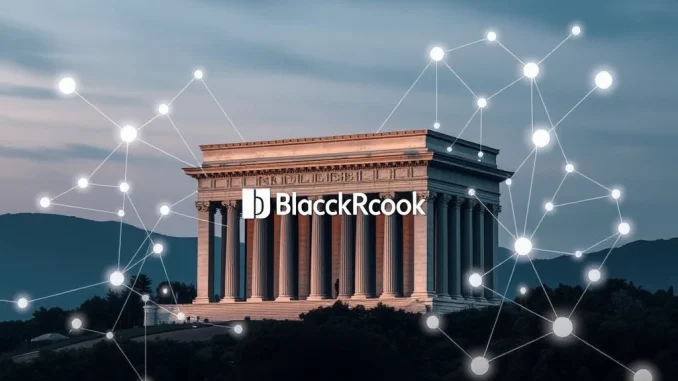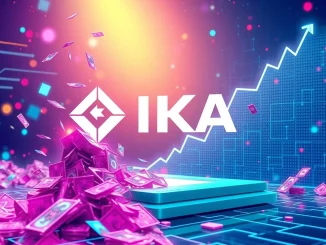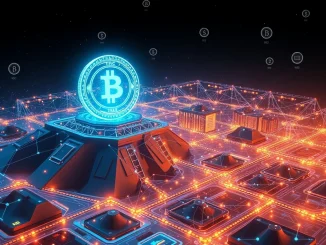
Big news from the world of traditional finance making waves in the blockchain space! BlackRock, the world’s largest asset manager with trillions under management, has just made a significant move that signals growing interest in digital assets. They’ve filed with the U.S. Securities and Exchange Commission (SEC Filing) to create a new digital share class for one of their massive funds. If you’re interested in how established finance is starting to interact with blockchain, this development is key.
BlackRock’s Bold Step: Introducing the Digital Share Class
According to reports, BlackRock is looking to introduce a new class of shares, specifically dubbed ‘DLT Shares,’ for its impressive $150 billion U.S. Liquid Assets Fund. This isn’t just any fund; it’s a major Money Market Fund, a staple of traditional finance used by corporations and institutions for cash management. The ‘DLT’ in DLT Shares stands for Digital Ledger Technology, which is essentially the underlying tech behind blockchain.
The filing indicates that the ownership of these DLT Shares would be reflected using blockchain technology. Think of it as recording who owns what on a secure, distributed digital ledger instead of just traditional paper or electronic records held by a central party. Bank of New York Mellon (BNY Mellon), a giant in financial services and custody, is slated to be the sole distributor for these DLT Shares.
Why is this development noteworthy?
- It’s BlackRock, the biggest player in asset management, making the move.
- It involves a large, established Money Market Fund ($150B).
- It explicitly mentions using blockchain technology for ownership records.
- BNY Mellon, a major custodian, is involved in the distribution.
What Does a Digital Share Class Mean for a Money Market Fund?
A Digital Share Class, particularly for a Money Market Fund, essentially means creating a tokenized version of the fund’s shares. Tokenization is the process of representing real-world assets or rights of ownership on a blockchain. In this case, the asset is a share in BlackRock’s Money Market Fund.
Instead of owning a share represented purely in a traditional brokerage account database, you would own a digital token on a blockchain that represents that share. This token would carry the same rights and value as a traditional share but exist on a digital ledger.
Key aspects of this approach:
- On-Chain Ownership: The blockchain serves as the definitive record of who owns the DLT Shares.
- Potential for Efficiency: Transactions (like buying or selling shares) could potentially be faster and cheaper if executed directly on a blockchain compared to traditional systems.
- Increased Transparency: While specific holder identities might be private, the transaction history and ownership structure could be more transparent on a public or permissioned blockchain.
It’s important to note that while the ownership is on the blockchain, the underlying assets of the Money Market Fund (short-term debt like Treasury bills, commercial paper, etc.) still exist in the traditional financial system. The DLT Shares are a digital wrapper or representation of the claim on those traditional assets.
Why is BlackRock Using Blockchain Technology for This?
BlackRock’s exploration of Blockchain Technology for this Money Market Fund likely stems from the potential efficiencies and innovations that digital ledgers can offer traditional finance. While the full scope of their plan isn’t entirely detailed in the initial filing, here are some potential reasons:
- Improved Settlement: Blockchain can enable near-instantaneous settlement of transactions, reducing the time and counterparty risk associated with traditional T+2 (trade date plus two days) or T+1 settlement cycles common in finance.
- Operational Cost Reduction: Streamlining processes like record-keeping, reconciliation, and transfers through automation on a blockchain could lower operational costs.
- New Distribution Channels: Tokenized shares could potentially be distributed and traded in new ways, although initial distribution is planned through BNY Mellon.
- Increased Accessibility (Future): While institutional funds are the focus now, tokenization could eventually pave the way for broader access to fractional ownership of traditional assets.
- Innovation and Future-Proofing: Exploring and implementing blockchain now positions BlackRock for a future where digital assets and tokenized securities may become more common.
This move aligns with a broader trend often referred to as the ‘tokenization of everything,’ where various asset classes, from real estate to art to financial securities, are being represented as digital tokens on blockchains.
The Role of the SEC Filing and Regulatory Landscape
The fact that BlackRock is making an SEC Filing for this Digital Share Class is crucial. It means they are going through the formal regulatory process required for offering securities in the United States. This isn’t a private, off-the-radar experiment; it’s a regulated product offering.
The SEC’s review of this filing will be closely watched. It represents a significant step in how regulators approach the integration of blockchain technology into traditional financial products like Money Market Funds. Approval would set a precedent and potentially open the door for other asset managers to follow suit.
Key regulatory considerations likely include:
- Ensuring investor protection and disclosure requirements are met in the digital format.
- Addressing custody and security of the digital shares.
- Defining the roles and responsibilities of participants (like BlackRock and BNY Mellon) in the blockchain ecosystem.
- Compatibility with existing financial regulations.
This SEC Filing highlights the ongoing dialogue and necessary steps for bridging the gap between traditional finance and the emerging world of digital assets.
What Does This Mean for the Future of Finance and Blockchain Technology?
BlackRock’s move into a Digital Share Class for a Money Market Fund is more than just a technical experiment; it’s a strong signal about the direction of traditional finance. It suggests that major institutions see real potential in leveraging Blockchain Technology for core financial products, not just speculative crypto assets.
This could be a harbinger of things to come:
- More tokenized funds across different asset classes (equities, bonds, real estate funds).
- Increased collaboration between traditional financial institutions and blockchain technology providers.
- Evolution of market infrastructure to support digital assets.
- Potential for increased liquidity and efficiency in traditionally illiquid markets through tokenization.
While the immediate impact on retail crypto investors might seem indirect, these developments lay the groundwork for a future financial system that could be significantly different, potentially integrating elements of decentralized technology into centralized finance.
In Conclusion: A Milestone for Digital Assets
BlackRock’s SEC Filing for a Digital Share Class in a $150 billion Money Market Fund is a landmark event. It underscores the increasing seriousness with which major financial players are exploring and adopting Blockchain Technology and digital assets. With BNY Mellon handling distribution and ownership recorded on a ledger, this initiative represents a concrete step towards integrating traditional finance with the digital asset space.
While regulatory approval is still needed, this move by BlackRock sends a powerful message about the potential future of asset management and highlights the growing convergence between the established financial world and the innovative capabilities of blockchain.



